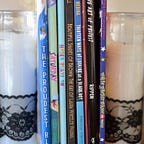Fannie Lou Hamer, Spirit of the Civil Rights Movement: the power of Carole Boston Weatherford’s prose poem
Rachel Amaru, Co-Founder Good Trouble For Kids
Good Trouble For Kids’ mission has been to use children’s literature as a platform for discussing literature and art, and illustrating how integral they can be to engaging in the current dialogue on critical race theory. Our goal has been to focus on how racially and socially conscious children’s books can be an entry way into exploring the history of race in America. Carole Boston Weatherford’s books are true models of the power of children’s books, and how much they are not just for children (no matter how they look). This is in the 11–14 age category because of its prose poems, the choice of layout, and the complexity of the text. Used in conjunction with Ms. Weatherford’s detailed end notes, it belongs in the toolbox of any parent or teacher who wants to go deeper into the history of women and the civil rights movement. I suspect, unfortunately, that I am not alone in confessing that the civil rights era names with which I am most familiar tend to primarily be men: Martin Luther King, Jr.; Medgar Evers; Andrew Young; Michael Schwerner; James Chaney; Harry Belafonte; Bob Moses; etc. This book, and the excellent resource of www.SNCC.digital.org (with a full section devoted to the women of SNCC) introduced me to Annie Devine and to Victoria Gray Adams, both of whom helped found the Mississippi Freedom Democratic Party, and to learning more about Ella Baker, who helped found SNCC.
Fannie Lou Hamer was rightfully called the “spirit of the Civil Rights Movement.” Malcolm X called her “the country’s number one freedom-fighting woman.” In 2021, it should come as no surprise that women have been, and are, the spine of social justice movements — from suffrage to 60’s era civil rights to today’s Black Lives Matter and trans rights. Everything Weatherford depicts in this book is relevant to today, from imparting the knowledge that “black is beautiful”; to the emphasis on voter registration (and the impediments including literacy tests and poll taxes); to recognizing the potential of women’s political power (still not realized enough); to the awareness that racism is “America’s problem.”
“It’s not only to free me in Mississippi,/ but it’s also to free yourselves/ because no man is an island.” (34)
Weatherford’s book provides a fantastic timeline of American history. Hamer, the granddaughter of slaves, was born in Mississippi in 1917 and remained in the South, even though much of her family was part of the great migration north. Her voice as a civil rights activist was entirely different from that of someone like Martin Luther King. Fannie Lou Hamer spoke to the experience of having been a sharecropper, of being self-educated, of being a mother (she adopted two children after a forced sterilization by a white doctor). She is famous for having said “All my life I’ve been sick and tired./ Now I’m sick and tired of being sick and tired.” Her accomplishments certainly speak to an enormous energy: she helped found the Mississippi Freedom Democratic Party and then ran for Congress, she was a national spokesperson for the Student Nonviolent Coordinating Committee (SNCC), she started a Head Start pre-school program, she co-founded the National Women’s Caucus. Her extraordinary testimony at the 1964 Democratic National Convention sounds as powerful today as it did then. Lyndon Johnson was so keenly aware of the power of her voice that he convened a press conference so the news would break away. This move backfired because her comments were replayed over and over again. You can listen to her full testimony here:
And, because my focus always returns to the uses of poetry as a tool of resistance, please listen to this rendition of Mahogany L. Browne’s powerful poem, “When Fannie Lou Hamer Said.”
And this one by June Jordan: 1977: Poem for Mrs. Fannie Lou Hamer
For more about Fannie Lou Hamer’s extraordinary life, please read this feature in the Magazine of the National Endowment for Humanities, that also includes a beautiful 1971 photo taken by Louis Draper for Essence Magazine.
I’ll end this with Fannie Lou Hamer’s unforgettable rendition of “This Little Light of Mine.”
Originally published at https://goodtroubleforkids.substack.com on September 15, 2021.
